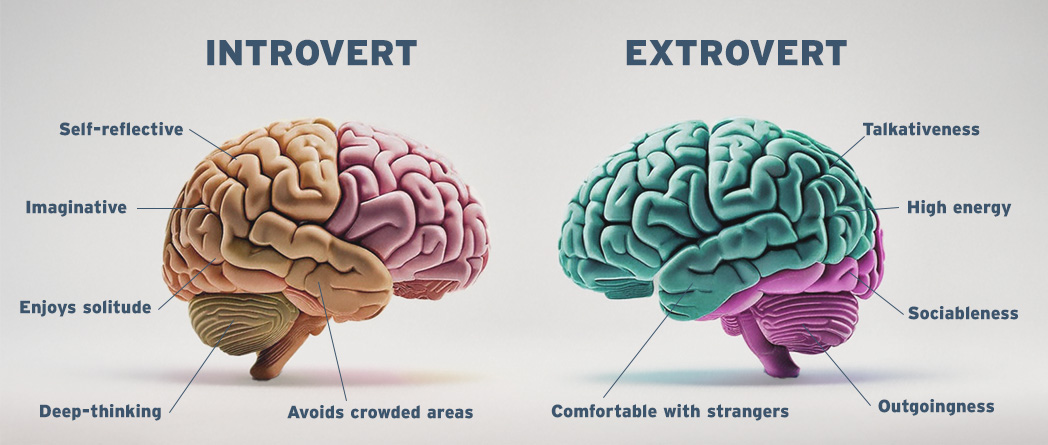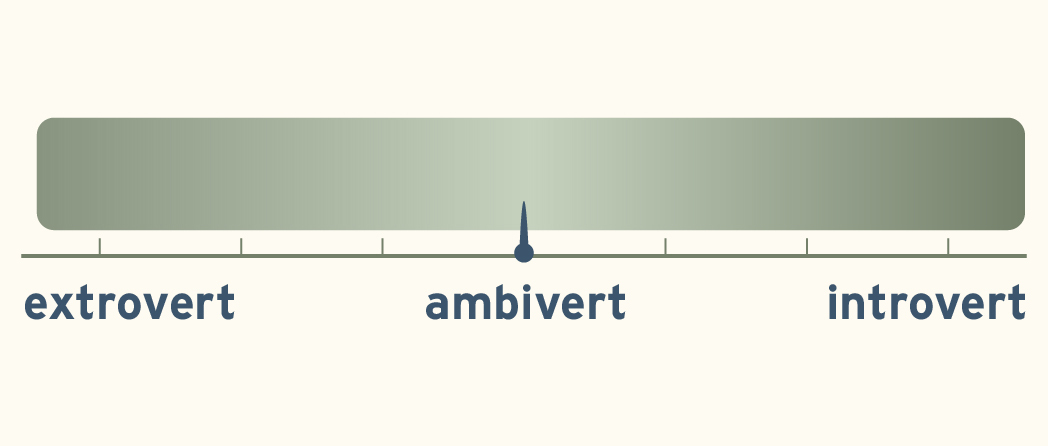Introversion and extroversion: shallow pop science or valuable assessments of our personalities?
Chances are, you’ve had someone tell you they’re an introvert or an extrovert, or perhaps you’ve been told yourself which one you are. Few personality theories have the reach and influence that introversion and extroversion has come to.
But is there much to this theory? What does it mean to say you’re one or the other, and is it “better” to be more introverted or more extroverted?
In this article, we’re going to dig into these questions and much more to provide a deeper understanding of introversion and extroversion. Knowing more about where you land on this spectrum can provide guidance in your relationships, work, and personal life.
Key takeaways
-
Carl Jung coined the term “introvert” in a lecture, which led to the first discussions of “extroversion” and “introversion”
-
Neurologically, introverts and extroverts are understood via differing rates of dopamine production
-
Introversion and extroversion are explored in trait theory, which is the study of personalities and includes different models for how we understand ourselves
-
Writers like Susan Cain demonstrate the hidden power of introverts, and how introversion can make for unique leaders in the workplace
-
“Ambiversion” describes people who sit in the middle of the spectrum, identifying as neither introverts nor extroverts
-
Whether introverted or extroverted, everyone can benefit from tips on how to approach work, relationships, and social situations (tips which this article will provide)
-
While many of us may not identify completely one way or the other, introversion and extroversion are useful tools for self-discovery
Where do the terms “introvert” and “extrovert” come from?
Pioneering psychiatrist and author of the influential “archetypes” theory Carl Jung developed the concepts. He first used the term “introvert” in 1909 during a university lecture, and the term appeared in print a year later.
Jung’s perspective is deeply rooted in psychoanalysis, so while his initial conception of the term is still relevant, our thinking about it has changed over time.
Through many interviews with his patients as a practicing psychiatrist, Jung determined the existence of two contrasting attitudes towards life:
-
Extroversion: an attitude characterized by its attraction to others, or “external objects"
-
Introversion: an attitude characterized by interest in “the subject”
Quoted in an article, Jung says that due to the extrovert’s interest in the external world of objects, its subject is left in the dark, unknown to itself or “shrouded in darkness”. The introvert, on the other hand, “holds aloof from external happenings, does not join in, [and] and has a distinct dislike of society”.
Our language has changed as introversion and extroversion have spread throughout culture. We’ve moved away from heavy use of terms like “subject” and “object”. Let’s look at our more contemporary understanding of the terms.

What does it mean to be an introvert or an extrovert?
From a neurological perspective, introversion and extroversion can be understood via dopamine distribution.
For the introvert, there is a high level of stimulation due to dopamine production, resulting in over-stimulation from crowded events and sensorially stimulating environments. The extrovert, who has a lower level of dopamine production, will seek out these kinds of high-stimulation environments to attain the same gratification the introvert receives with very little stimulation.
Introverts
It’s much less common now to describe introverts in the negative terms used by Jung, namely their “dislike of society”. Introverts can find some social situations draining, and often are more energized by hobbies or interactions with smaller groups. We also understand introversion more commonly now as exhibiting these characteristics:
-
Self-reflective
-
Enjoys solitude
-
Avoids crowded areas
-
Imaginative
-
Deep-thinking
Extroverts
Contrary to introverts, the extrovert is energized by gains energy from socializing and stimulating environments. Common characteristics of the extrovert include:
-
Outgoingness
-
Talkativeness
-
High energy
-
Sociableness
-
Comfortable with strangers

Introversion, extroversion, and trait theory
“Personality” as a concept has occupied the studies of ancient philosophers and contemporary psychologists alike.
One of the common ways in which we understand personalities is through “trait theory”. Trait theory is concerned with the measurement of traits, which we define as patterns of behavior, thought, and emotion. When these patterns become habitual, it provides a more consistent picture of one’s personality.
Introversion and extroversion are two such traits. Theorists employing trait theory use different models to study personality, including the following:
-
Questionnaires
-
Indicators
-
Emotion wheels
These models help to narrow down a person’s habitual traits, seeking to place them in resulting categories which then inform the user further about their personality.
One of the most popular models for determining a person’s place along the scale of introversion and extroversion is the Big Five Personality Test.
“Extroversion” is a factor in this personality test, and it is measured through questions that help the test taker to understand their tendency to be drawn to extroverted activities. These include things like breadth (as opposed to depth) of activities, where the person gains energy from, and reactivity to social situations.
The Big Five personality theory was developed in the 1990s and proposes that our personality traits are biological in nature, usually inherited genetically.
This has become one of the most effective tests for measuring a person’s propensity towards introversion or extroversion. Through questions that measure your responses to situations, preferences for socializing, types of interests, and more, users can better understand how introversion and extroversion play roles in their lives.


In the next sections, we’ll go into more detail about how introversion and extroversion can impact and guide our daily lives, as well as discuss some more contemporary perspectives.
The challenges introverts face
Our world often rewards socially confident, outgoing people. High-level positions at work require us to give presentations, attend conferences, and lead meetings. Finding a romantic partner often means attending parties, standing out in the crowd, and striking up conversations with strangers.
It feels as if, to succeed in many areas, we must “sell” our personality to others. This idea can sometimes cause anxiety for introverts.
Susan Cain and reclaiming the power of the introvert
Susan Cain, author of Quiet: The Power of Introverts in a World That Can't Stop Talking, discussed the prevalence of an “extroversion bias” in our culture. “In our society,” she says, “the ideal self is bold, gregarious, and comfortable in the spotlight”. Our institutions are designed for extroverts. We are even made to feel guilty for wanting to spend time alone.
With her book, Cain seeks to illuminate the often-ignored brilliance of introverts. Just because a person isn’t always the first one to share their ideas, does not mean they do not have any. And the same can be said for those who speak their minds frequently:
“There's zero correlation between being the best talker and having the best ideas.”
Cain discusses famous leaders who were introverts, while pointing out that introverts can make for better leaders in certain circumstances. They are more likely to let talented employees develop ideas in peace, rather than needing to “put their stamp on things”. Introverts are also less motivated by “ego or a desire for the spotlight” and are instead dedicated to the wider goal.
Introversion and extroversion refer to what stimulates us. What’s important is creating the right environments in which we can thrive.
In the next two sections, we’re going to discuss some of the common aspects of daily life for both introverts and extroverts, to see how they differ.
We’ll cover relationships, social situations, and common work scenarios, providing advice for when these scenarios present challenges.
Extroverts in everyday life
The popular perception of extroverts is that they have it easy: they enjoy socializing and meeting people, they have no fear of speaking up at work, and they aren’t bothered by being the center of attention.
Much of this may be true, however, extroversion is often misunderstood and has its own particularities worth discussing.
If you are high in extroversion, you likely enjoy work that requires you to show up in person and interact with people daily. Extroverts are often good at remembering faces and names, work well in group settings, and are first one asking if anyone wants to join for lunch.
All these qualities make for a valuable and likeable colleague. However, there are certain cases in which a high level of enthusiasm can have unintended consequences. Below are a few things to keep in mind for extroverts. These do not apply to all extroverts, nor do they signify negative qualities:
-
Don’t take the spotlight too much. It’s good to voice your opinion in meetings but be mindful of how much you do it. You risk alienating other colleagues and may discourage them from speaking. Instead, ask for further input from everyone else when you finish speaking, or wait 30 seconds after feedback prompts, in case anyone else wants to speak.
-
Temper your emotions. Drawing energy from social situations, extroverts become heavily invested in discussions, possibly even argumentative. To you, this is just showing passion. To others, you might appear upset, even aggressive. If a certain situation at work is getting your heartrate up, or perhaps you notice you’re raising your voice, stop and take a breath. Pause and listen to what others are saying. Continue in a tempered tone of voice.
-
Organize your focus time. Many jobs, even ones suited to the most extroverted people, require some reading, concentration, and focus time. Alone time can be daunting to extroverts. If you’re dreading an upcoming task that requires deep concentration and solitude, plan ahead. Work in short bursts of 30 minutes, ask a colleague if you can discuss the information afterwards, and see if video or audio versions of the material suit you better.

Extroverts in relationships
Characterized by enthusiasm for experiences and outgoing sociability, it’s possible that extroverts can expect a lot from their partners in relationships. If two extroverts are in a relationship together, this might be an ideal scenario, but it isn’t always the case.
Opposites attract and we often form relationships with people positioned differently to them along the introversion/extroversion spectrum. If this is the case, here are some useful things to keep in mind for extroverts in relationships:
-
Learn your partner’s communication style. As an extrovert, you may be comfortable thinking out loud and voicing your feelings. It’s important to know that, whether your partner is introverted or not, this might not be how they operate. If your partner isn’t externalizing that something is bothering them or that they need help with something, there may be more lying under the surface. Show that you’re paying attention by sitting down with them on a regular basis and giving them the space to speak freely.
-
Be mindful of the other connections you make. Extroverts make friends easily and this is a wonderful quality. However, remember that when you’re making friends fast in social situations, this might contrast with your partner’s experience. They may be confused and even hurt by seeing their partner so close with strangers. Remember to regularly show affection and attention to your partner. Introduce your new friends quickly to your partner to remind them they aren’t forgotten.
Extroverts in social settings
Extroverts are known for thriving in social settings because interactions with others charges their social batteries. This can make it easy to meet and make new friends and have adventures, always seeking out the next exciting thing.
There are certain things to consider as an extrovert in social settings, regarding self-care and balancing your energy around others.
-
Time spent alone is still important. Susan Cain encourages extroverts to spend more time alone, saying that “if you really want to find out how you feel about something, you have to seclude yourself to some degree”. It becomes unhealthy to constantly surround ourselves with others, because we drown out the things going on inside of us. Since extroverts are so energized by highly stimulating environments, it’s important to observe when you are avoiding alone time, and for what reasons.
-
Understand your friends may have different social batteries than you. Learn to recognize the things your social group likes to do. Extroverts often enjoy the role of a leader and may take over making plans in social scenarios. It’s important then to recognize that some people may feel pressured into things by people with a more extroverted nature than them. Make sure you hear everyone’s needs before making decisions.
Introverts in everyday life
Introverts are generally reflective, deep-thinking, and need time to recharge their social batteries. Navigating work, relationships, and socializing can impinge upon the needs of an introvert.
Let’s discuss these major factors in life with the needs of an introvert in mind. It’s important not only to understand your own needs in daily life, but also those of the people around you.
Introverts at work
When you’re pursuing a career, it’s important to demonstrate the skills you bring to the table and to make your accomplishments known, which can be tricky for introverts.
Discussing introverts in the workplace, Melody Wilding with the Harvard Business Review writes that introverts prefer to remain behind the scenes, happy to give the spotlight to someone else.
While this tendency is admirable, it comes with pitfalls, especially in the modern, remote-first work world where being “out of sight” often equates to being “out of mind.” Perhaps you’ve been overlooked for a promotion because a senior leader wasn’t aware of you or your accomplishments.
Regardless of the high quality of your work, remaining behind the scenes could be detrimental to your career.
In today’s workplace, she says, “hard work isn’t enough”. So, what can you do to stand out more without sacrificing your needs?
-
Speak up in meetings. You don’t have to run the meeting, just make sure you’re contributing. Check the agenda beforehand and see if there’s a point at which you’d like to speak up. Make yourself known and provide a valuable contribution to the meeting.
-
Use confident language. It’s common for introverts to minimize the value of their work with phrases like “I probably did this wrong, but…” or “Sorry if this is irrelevant…” Instead, try to ignore the impulse to use these phrases and just state your intentions. Try out the sentence without any self-deprecating language attached first.
-
Plan your communication. It can be intimidating for introverts to hold spontaneous meetings or take over the communicative role in projects, so try to plan your communication ahead of time. Send out newsletters, emails, or another format that prevents you feeling put on the spot to talk.

Introverts in relationships
Relationships can cause friction. We are letting a person into our life and becoming a part of theirs. And since opposites attract, we may find ourselves heavily involved with someone who sits at the opposite end of the extroversion/introversion spectrum as we do.
Certain conflicts can arise when introversion is a strong presence in the relationship:
-
Conflicts over attending social gatherings
-
Quietness or “alone time” interpreted as unkind
-
Personal boundaries being misunderstood
-
Different approaches to conflict and resolution
But introversion is not the cause of these conflicts. Misunderstanding your partner’s needs or having trouble communicating your own needs is what causes conflicts that can have negative impacts on your relationships. When introversion plays a role in your relationship, keep these things in mind:
-
Make sure your partner knows your tendencies. Simply tell your partner that you consider yourself introverted. This is the easiest way to start things off on the right foot. Educate them on what this means and how it has impacted your life so far.
-
Find time for meaningful talks. Introverts often like to talk things out in a safe space, so find time for this when it feels like the moment is needed. As an introverted person, you may have to remind your partner when that is.
-
Understand their needs with regards to socializing. Socializing is a big factor in relationships. Are you comfortable joining your partner at the next party, or would you prefer to stay at home? Stay open to your partner going out without you and remember there’s no need to feel guilty for staying home.
Introverts in social settings
Being an introvert doesn’t mean you dislike social settings or even that you don’t thrive in them. It’s more likely the case that you prefer certain types of socializing. This could mean you prefer one-on-one time with a friend, activity-focused events like boardgame nights, or going out and dancing. What’s important is that you know what you like.
If you don’t understand your preferences well or your friends don’t know what you like, this can lead to discomfort for you and misunderstandings for friends.
Keep some of these things in mind to ensure you socialize comfortably, and your friends know what to expect from you:
-
Make sure your friends know your preferences. Communication is always key. If your friends know about your introverted tendencies, they’re far less likely to respond negatively when you decline an invitation.
-
Develop your own ritual when attending social events. Take a walk around the block before going into the bar or venue. Listen to your favorite song or podcast. Decide beforehand how long you’ll stay. Ask a friend to inform others when you leave, if telling everyone makes you feel on the spot. The idea is to gain control over situations that you feel it is taken from you.
-
Keep up with one-on-one interactions. If you miss a good friend’s birthday party, see them next week for a coffee. Ensure that your friends know you care about them and want to see them by organizing the kinds of social events you’re more comfortable with.
What is an ambivert?
Introversion and extroversion sit on a spectrum, along which we usually find ourselves somewhere in the middle, leaning to one side more than the other. Studies show that many people don’t strictly identify as either extroverted or introverted, however.
Those situated strongly in the middle of the spectrum are called “ambiverts”.
Ambiversion is characterized by flexibility, with the ability to adjust according to the situation.
Where introverts and extroverts experience opposing degrees of stimulation due to dopamine levels in the neocortex, the distribution of dopamine for ambiverts is more balanced. They are less likely to be over-stimulated and need to withdraw, or under-stimulated and restless.

Is it “better” to be an introvert or an extrovert?
Like most things in life, there isn’t a clear answer to this question. Instead, we can look at the ways in which we comfortably navigate through the world, focusing on what helps us to thrive.
Adding to this, we all share traits of both introversion and extroversion, even if we lean one way or the other. Trait theory, the Big Five, and introversion/extroversion are all tools we use to help understand where we land on this spectrum.
Introversion and extroversion can carry potential benefits in certain situations, but if we know ourselves, we can exert more control over the environment around us. When we create optimal environments for ourselves and learn to deal with situations to minimize discomfort, we can work better, socialize more enjoyably, and indulge in the hobbies and activities that suit us best.



